The AMD Radeon R9 290X Review
by Ryan Smith on October 24, 2013 12:01 AM EST- Posted in
- GPUs
- AMD
- Radeon
- Hawaii
- Radeon 200
Battlefield 3
Our major multiplayer action game of our benchmark suite is Battlefield 3, DICE’s 2011 multiplayer military shooter. Its ability to pose a significant challenge to GPUs has been dulled some by time and drivers, but it’s still a challenge if you want to hit the highest settings at the highest resolutions at the highest anti-aliasing levels. Furthermore while we can crack 60fps in single player mode, our rule of thumb here is that multiplayer framerates will dip to half our single player framerates, so hitting high framerates here may not be high enough.
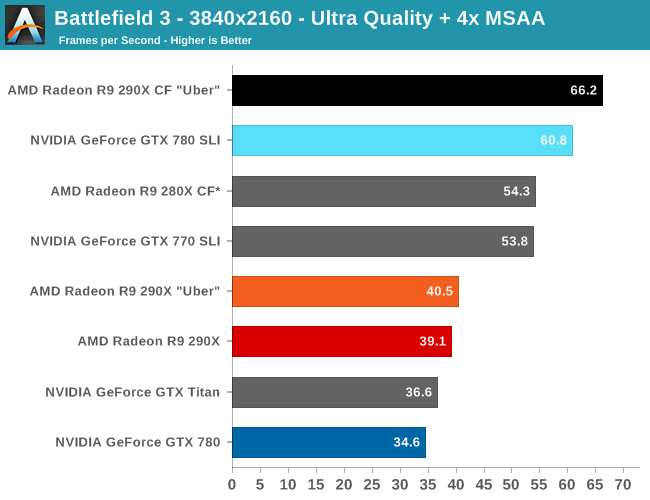

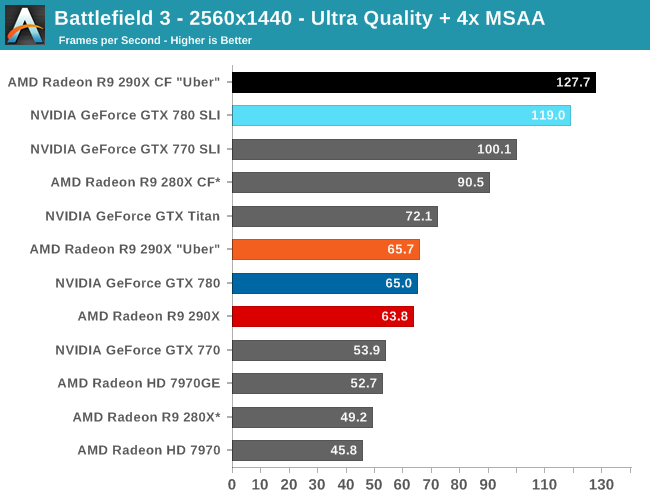
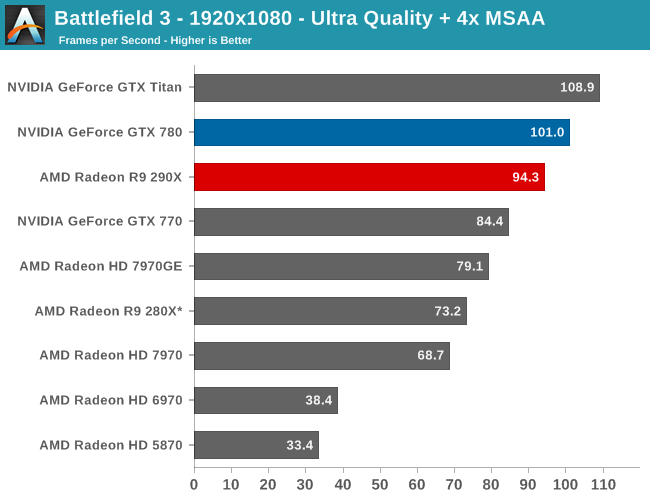
For our Battlefield 3 benchmark NVIDIA cards have consistently been the top performers over the years, and as a result this is one of the hardest fights for any AMD card. So how does the 290X fare? Very well, as it turns out. The slowest game for the 290X (relative to the GTX 780) has it losing to the GTX 780 by just 2%, effectively tying NVIDIA’s closest competitor. Not only is the 290X once again the first single-GPU AMD card that can break 60fps average on a game at 2560 – thereby ensuring good framerates even in heavy firefights – but it’s fully competitive with NVIDIA in doing so in what’s traditionally AMD’s worst game. At worst for AMD, they can’t claim to be competitive with GTX Titan in this one.
Moving on to 4K gaming, none of these single-GPU cards are going to cut it at Ultra quality; the averages are decent but the minimums will drop to 20fps and below. This means we either drop down to Medium quality, where 290X is now performance competitive with GTX Titan, or we double up on GPUs, which sees the 290X CF in uber mode take top honors. This game happens to be another good example of how the 290X is scaling into 4K better than the GTX 780 and other NVIDIA cards are, as not only does AMD’s relative positioning versus NVIDIA cards improve, but in heading to 4K AMD picks up a 13% lead over the GTX 780. The only weak spot here for AMD will be performance scaling for multiple GPUs, as while the 290X enjoys a 94% scaling factor at 2560, that drops to 60% at 4K, at a time where NVIDIA’s scaling factor is 76%. The 290X has enough of a performance lead for the 290X CF to hold out over the GTX 780 SLI, but the difference in scaling factors will make it cut close.
Meanwhile in an inter-AMD comparison, this is the first game in our benchmark suite where the 290X doesn’t beat the 280X by at least 30%. Falling just short at 29.5%, it’s a reminder that despite the similarities between 290X (Hawaii) and 280X (Tahiti), the performance differences between the two will not be consistent.

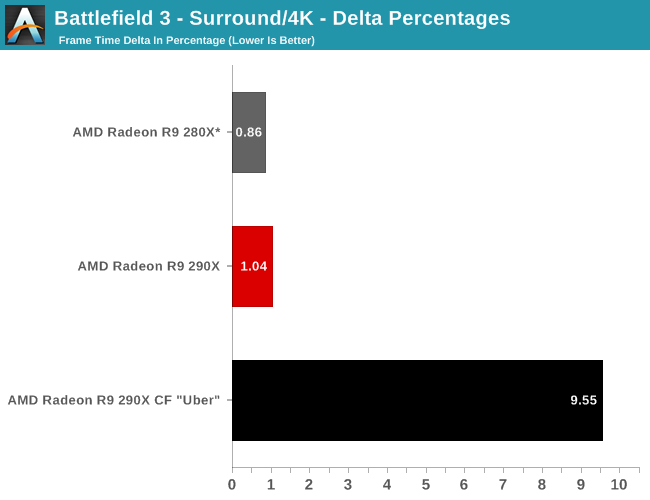
Looking at our delta percentages, this is another strong showing for the 290X CF, especially as compared to the 280X CF. AMD has once again halved their variance as compared to the 280X CF, bringing it down to sub-10% levels. This despite the theoretical advantage that the dedicated CFBI should give the 280X. However AMD can’t claim to have the lowest variance of any multi-GPU setup, as this is NVIDIA’s best game, with the GTX 780 SLI seeing a variance of only 6%. It’s a shame not all games can be like this (for either vendor) since there would be little reason not to go with a multi-GPU setup if this was the typical AFR experience as opposed to the best AFR experience.
Finally, looking at delta percentages under 4K shows that AMD’s variance has once again risen slightly compared to the variance at 2560x1440, but not significantly so. The 290X CF still holds under 10% here.


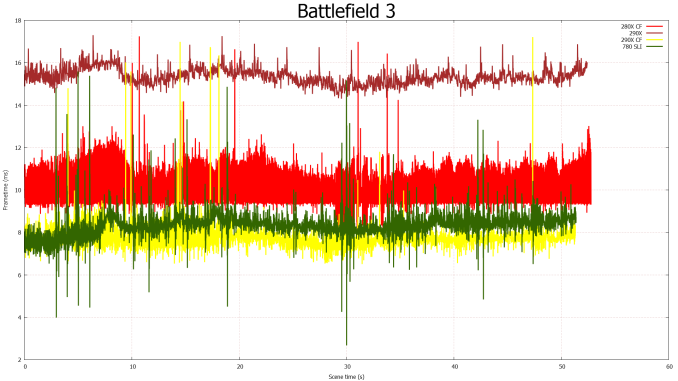
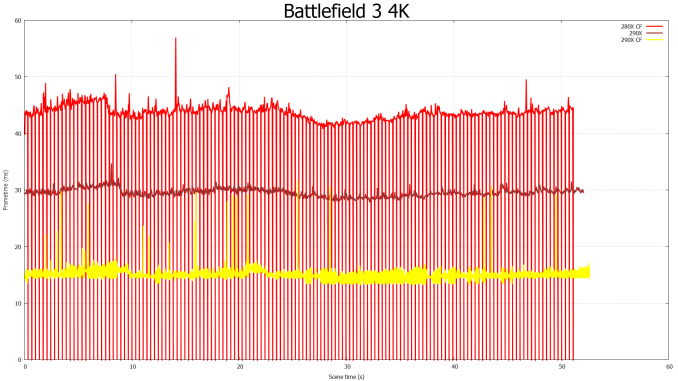








396 Comments
View All Comments
heflys - Thursday, October 24, 2013 - link
Slightly slower than a 780 overall? Even in Uber mode? Can you link me to these reviews if possible?Shark321 - Thursday, October 24, 2013 - link
I didn't say that. It's slightly slower in Uber Mode than Titan overall in 1080p (across all sites combined). In Quiet mode it's usually slightly faster than 780, slighttly slower in the minority of the reviews.heflys - Thursday, October 24, 2013 - link
I see now.Jumangi - Thursday, October 24, 2013 - link
What noob would buy a 290x or a Titan and run it in 1080p? A pointless resolution for these cards.
inighthawki - Thursday, October 24, 2013 - link
What an arrogant post. There are tons of people who game on 1080p displays and buy a 290X or a Titan. Having a high framerate (i.e. consistently greater than 60fps) reduces the likelihood of stuttering while playing, while also making your system a bit more future-proof as new games come out. Not everyone cares about pixel count, some care more about quality per pixel. As you start seeing titles ship on Unreal 4, post-Crysis 3, etc, I will be laughing at you when I can still run my games at native resolution without the need to upscale or reduce quality.puppies - Saturday, October 26, 2013 - link
Anyone who buys a titan to play games at 1080p is insane, seriously they need locking up. You claiming otherwise does nothing.Samus - Thursday, October 24, 2013 - link
agreed. this card is for 2560x1440+ or multimonitorTheJian - Friday, October 25, 2013 - link
ROFL...Only if you don't believe in MAXING your games. Which nobody can do with a single card. Many sites comment on this, and show mins, even here with lower settings they hit below 30fps in a few of their games at 2560. In multiplayer you'd get crushed by guys hitting much higher fps at 1080p in many games. Maybe you'll be right at 20nm, but certainly there are far too many games you have to jockey settings around on to make you right today.reddev - Thursday, October 24, 2013 - link
Both LinusTechTips and OC3D, two reviewers I trust quite a bit, have it below the 780.randomhkkid - Friday, October 25, 2013 - link
Linus tech tips over clocks all the cards it tests, since the 780 has much more headroom (on the stick cooler) the gains were larger than the 290x so at stock the 290x is faster.